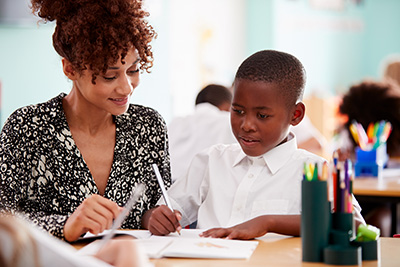What strategies can educators implement to prevent or address challenging behaviors?
Page 2: Behavior-Specific Praise
 Behavior-specific praise is a positive statement directed toward a student or group of students that acknowledges a desired behavior in specific, observable, and measurable terms. An educator using behavior-specific praise explicitly states the exact behavior the student demonstrated to meet expectations.
Behavior-specific praise is a positive statement directed toward a student or group of students that acknowledges a desired behavior in specific, observable, and measurable terms. An educator using behavior-specific praise explicitly states the exact behavior the student demonstrated to meet expectations.
By reinforcing positive behaviors, behavior-specific praise is a highly effective strategy that educators can use both to increase positive behavior and decrease challenging behaviors. Although educators can use general praise to reinforce student behavior, behavior-specific praise is proven to be a more effective strategy. In the table below, note that the examples of behavior-specific praise 1) identify the student who met the behavioral expectation and 2) clearly describe that behavior. In comparison, general praise could cause the students to wonder what it was they did well.
| General Praise | Behavior-Specific Praise |
| “Nice work, yesterday!” | “Kai, I like how you followed directions the first time. I really enjoyed your reading.” |
| “Good job, Nora.” | “Nora, great job sitting quietly when other students were asking questions.” |
Research Shows
- The use of behavior-specific praise is linked to increases in students’ on-task behavior and decreases in their challenging behavior.
(Royer, Lane, Dunlap, & Ennis, 2019) - Behavior-specific praise can be effectively used to support students with or at risk for emotional and behavioral disorders (EBD).
(Downs, Caldarella, Larsen, Charlton, Wills, Kamps & Wehby, 2019, Allday, Hinkson-Lee, Hudson, Neilsen-Gatti, Kleinke, & Russel, 2012; Sutherland, Wehby, & Copeland, 2000)
Using the Strategy
To help educators prevent or address challenging behavior, the table below describes the steps to implement behavior-specific praise and provides an example.
| Steps | Description | Example |
|
Establish and explicitly teach behavioral expectations—the behaviors you want your students to display. |
The teacher identifies the following behavioral expectation. Classroom: Follow directions. Because Sofia has difficulty has difficulty following directions during independent practice, the teacher establishes the following expectation for Sofia. Student: Sofia will stay at her desk during independent practice. |
|
During instructional time, transitions, or down time, look for students engaging in the desired behaviors. | The teacher observes that Sofia stays at her desk while completing math problems during independent practice. |
|
Frequently offer behavior-specific praise to the student by stating the student’s name and describing the behavior immediately after she performs it. | The teacher says, “Sofia, great job staying at your desk while you were working.” |
In this video, Mr. Santini uses behavior-specific praise during a brief transition in class activities (time: 0:31).
Transcript: Behavior-specific praise
Teacher: [To class] Alrighty friends, we’re going to read a passage about the landmarks in Tennessee. Would someone like to volunteer to pass out the readings?
Teacher: Thank you, Kayla.
Teacher: Colin, nice job sitting quietly.
Teacher: Kai, excellent job showing me you’re ready for reading by sitting quietly.
Kai: Thanks.
Teacher: Thank you, Kayla.
Teacher: Okay, so…
In addition to the three steps listed above, the four actions below can be helpful when implementing this practice.
Gather data or reflect on how often you offer general praise and behavior-specific praise to the student.
Example: A teacher (or paraeducator) marks a plus or a minus on a clipboard every time he gives positive or negative feedback to a student. He determines he is providing twice as many corrective statements to praise.
In the beginning it may feel fake or forced to use behavior-specific praise. Consider writing down a statement and practicing your praise out loud to become more comfortable and to make sure you are delivering it in a sincere tone of voice.
Self-monitor your use of praise by keeping a tally of praise statements during each class period to ensure at least a 4:1 ratio of praise to corrective statements. Students with challenging behavior often have difficulty meeting the established behavioral expectations and, therefore, have fewer opportunities to receive praise. As such, the teacher might need to offer praise more frequently, perhaps every few minutes. Once the student spends more time engaged in the desired behavior, the teacher can decrease the frequency of praise, though still maintaining a ratio of four praises for every one corrective statement.
Check in with students to see how comfortable they are with receiving behavior-specific praise. This can be done by speaking with students individually or asking the class to fill out a feedback form. Younger elementary school students may respond well to enthusiastic praise that occurs in front of the entire class, while older elementary students may prefer subtle praise statements. Regardless of age, some students may find verbal praise in front of others embarrassing. To meet the needs of these students, you can provide praise in a one-on-one setting or in a non-verbal manner (e.g., in a note).
In the first interview, Harold Holmes describes why it’s important to use behavior-specific praise equitably. Next, Janel Brown discusses how providing behavior-specific praise to one student can influence the behavior of other students.
Transcript: Harold Holmes
I think behavior-specific praise should be throughout the day. You quickly do it and you make sure that you’re doing it for everyone. You may have a kid who’s a frequent flier who always has problems. You may find that you’re not praising that student at all. This is the student who’s the loudest, who disrupts the most, and you may be happy that that student is quiet. A first-year teacher may think that if you’re giving positive praise to the kids who are acting right, you’re okay. But to the child, you’re just showing favoritism. So, I think behavior-specific praise should be done throughout, and it should be equitably applied for everyone, equally across the students, no matter how challenging they may be.
Transcript: Janel Brown
So, behavior specific praise… When you are in the middle of your instruction, you have given your students instructions, and everyone is working. Suppose Johnny he’s off coloring or doing something that he’s not supposed to be doing. You don’t want to call him out in front of the class. That could be embarrassing. But if Johnny is supposed to be with Michelle and her group, you praise Michelle. “Michelle, I love how you’re sitting, and you’re writing, and you’re having a discussion with Sally. I really appreciate you guys following directions.” Then that’s going to tell Johnny, “I want that kind of praise. I want my teacher to be proud of me and what I’m doing.” Johnny’s going to go back to doing what he’s supposed to be doing so that he can get that praise as well. You walk around, and then you go back to Johnny. “Oh, Johnny, Ms. Brown is so proud of you. I’m so glad how you’re interacting with your group.” In that moment, he’s the happiest kid in the world. So next time, Johnny may not be so quick to veer off and do something else. He’s going to do what he’s supposed to be doing because he wants that praise specific to what he’s supposed to be doing. And he wants everybody to hear it.
Tier 2 Support
Although behavior-specific praise can be used as a Tier 1 strategy, it can also be used as a Tier 2 support for students with moderate levels of externalizing or internalizing behaviors. The steps are the same as when used as a Tier 1 support, but for Tier 2 the educator delivers the praise with greater intensity (e.g., more frequently). To determine if the strategy is effective, the educator collects and analyzes the data using the following steps:
- Identify the student behavior to be addressed (e.g., student puts head down and refuses to work) during an instructional period in which the behavior typically occurs (e.g., science, math).
- Collect baseline data on the student behavior for a designated timeframe (e.g., first 20 minutes of class) during the identified instructional period. Collect this data across several days (e.g., 3 to 5 days) to see how often this behavior occurs or how long each episode lasts.
x
Baseline data
The measure of the level of a student’s academic or behavioral performance before a change (e.g., instructional or behavioral practice or intervention) is implemented. This information can be compared to data collected after the change has been implemented to evaluate student progress.
- Implement or intensify behavior-specific praise and continue to collect data (e.g., same instructional period, same length of time) for 3 to 5 days to determine whether the student’s behavior changes.
- Evaluate the effect of behavior-specific praise. Compare the implementation data to the baseline data to evaluate whether the strategy has had the desired effect on the student’s behavior.
To learn more about identifying student behavior and collecting data, view these IRIS Case Studies:
Although this strategy works as a Tier 1 support, it is also effective as a Tier 2 support when working with students who consistently display challenging behaviors. For these students, educators should:
- Identify specific behaviors they want students to demonstrate.
- Frequently observe the student to identify instances of desired behavior.
- Increase the frequency of behavior-specific praise (e.g., 9 praise statements to every 1 corrective statement)

To make sure you are using this strategy with fidelity, download this behavior-specific praise implementation checklist. To view our IRIS Fundamental Skill Sheets on behavior-specific praise, click on each title below. |

